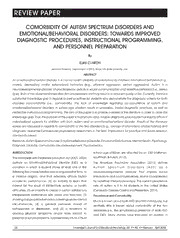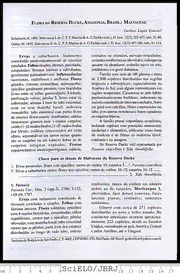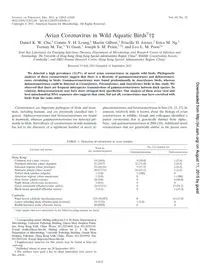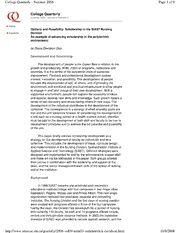
ERIC EJ1131864: Comorbidity of Autism Spectrum Disorders and Emotional/behavioral Disorders: Towards Improved Diagnostic Procedures, Instructional Programming, and Personnel Preparation PDF
Preview ERIC EJ1131864: Comorbidity of Autism Spectrum Disorders and Emotional/behavioral Disorders: Towards Improved Diagnostic Procedures, Instructional Programming, and Personnel Preparation
REVIEW PAPER S COMORBIDITY OF AUTISM SPECTRUM DISORDERS AND EMOTIONAL/BEHAVIORAL DISORDERS: TOWARDS IMPROVED DIAGNOSTIC PROCEDURES, INSTRUCTIONAL PROGRAMMING, AND PERSONNEL PREPARATION By ELIAS CLINTON Assistant Professor, Department of SPED, Black Hills State University, USA. ABSTRACT An emotional/behavioral disorder is a mental health disability characterized by intensive internalized behaviors (e.g., anxiety, depression) and/or externalized behaviors (e.g., physical aggression, verbal aggression). Autism is a neurodevelopmental disorder characterized by deficits in social communication and repetitive behaviors (i.e., stereo type). Both of the aforementioned disorders are persistent and may result in a reduced quality of life. Currently, there is a substantial knowledge gap in regards to best practices for students who demonstrate the diagnostic criteria for both disorders concomitantly (i.e., comorbidity). The lack of knowledge regarding co-occurrence of autism and emotional/behavioral disorders in school-age children results in unreliable, invalid diagnostic practices, as well as ineffective instructional programming. The aim of this paper is to provide a review of the literature in order to close this knowledge gap. Thus, the purpose of this paper is to promote valid, reliable diagnostic procedures that lead to efficient individualized supports for children with both autism and an emotional/behavioral disorder. Results of the literature review are discussed in regards to comorbidity of the two disorders (e.g., overlap of phenotypic characteristics) and diagnostic assessment procedures proposed by researchers in the field. Implications for practice and future research are also discussed. Keywords: Autism Spectrum Disorder, Emotional/Behavioral Disorder, Emotional Disturbance, Mental Health, Psychology, Diagnosis, Disability, Comorbidity, Neurodevelopment, Psychometrics. INTRODUCTION school-age children are affected by an EBD (Hallahan, The Individuals with Disabilities Education Act (IDEA, 2004) Kauffman, & Pullen, 2013). defines an Emotional/Behavioral Disorder (EBD) as a The American Psychiatric Association (2013) defines condition in which a student shows at least one of the Autism Spectrum Disorders (ASD) as a following five characteristics over a long period of time, to neurodevelopmental disorder that impairs social a marked degree, and that adversely affects his/her interactions and communications, and is characterized academic performance: (1) an inability to learn that by repetitive interests/stereotypy. The current prevalence cannot be the result of intellectual, sensory, or health rate of autism is 1 in 68 students in the United States difficulties, (2) an inability to create or sustain satisfactory (Centers for Disease Control and Prevention, 2014). interpersonal relationships with peers and teachers, (3) Prevalence and Comorbidity showing inappropriate behaviors or feelings under normal Much is known about both ASD and EBD individually, but circumstances, (4) a general pervasive mood of relatively little is known about comorbidity of the two unhappiness or depression, and (5) a tendency to disabilities (i.e., the simultaneous presence of both ASD develop physical symptoms and/or fears related to and EBD). Many studies have indicated an overlap in personal or school problems. Approximately 6% to 10% of 38 i-manager’s Journal on Educational Psychology, Vol. 9 l No. 4 l February - April 2016 REVIEW PAPER S defining diagnostic features of ASD and EBD as well as the from the supports provided to learners with EBD. For complexity of discerning between the two disorders students with ASD, effective practitioners utilize particular (Georgiades et al., 2011; Magyar & Pandolfi, 2012; evidence-based interventions and supports such as: Maskey, Warnell, Parr, Le Couteur, & McConachie, 2012). Visual support systems, Augmentative and Alternative Magyar and Pandolfi (2012) indicated that, a high communication (e.g., PECS, speech generating percentage of school-age children with ASD frequently devices), ensuring predictability in routine, structured work demonstrate characteristics consistent with an EBD (e.g., systems, and pivotal response training (Breitenbach, anxiety, depression, inattention, irritability, hyperactivity, Armstrong, & Bryson, 2013; Lovannone, Dunlap, Huber, & impulsivity, aggression, and defiance). Additionally, the Kincaid, 2003; Simpson, 2005). Likewise, students with EBD author reported that, relatively little is known about often require unique interventions and supports such as: comorbidity of the two disorders (e.g., best practices for Social skills training, group-oriented contingencies, identification/diagnosis, best practices for treatment, private areas for independent work or breaks, direct exact prevalence rates). The aforementioned knowledge instruction, and self-monitoring (Harrison, Bunford, Evans, gap results in unreliable, invalid diagnosis in school-age & Owens, 2013; Landrum, Tankersley, & Kauffman, 2003; children. Furthermore, this lack of knowledge is Wagner, Kutash, Duchnowski, Epstein, & Sumi, 2005). In problematic as both ASD and EBD are persistent and may order to cultivate positive educational outcomes for those result in a reduced quality of life if evidence-based students with comorbid ASD and EBD, practitioners must practices are not deployed for affected learners by be highly-trained to deploy each of the aforementioned competently trained practitioners (Gadow, DeVincent, interventions and support with efficacy. Additionally, those Pomeroy, & Azizian, 2004; Howlin Goode, Hutton, & Rutter, same practitioners must have a comprehensive 2004; Magyar & Pandolfi, 2012). knowledge of strategies applicable to serving students Need and Rationale of the Study with both disorders such as: methods for teaching appropriate replacement behaviors (i.e., differential The Individuals with Disabilities Education Act (IDEA, 2004) reinforcement), extinction, identifying functions of outlines thirteen separate disability categories. Thus, the behavior, reduction of self-injurious behavior, modifying machine of Special Education (SPED) operates via a antecedents (i.e., environmental engineering), altering categorical engine. The debate concerning the consequences of behavior, behavior specific praise, ethics/logistics of a categorical approach to SPED is not functional life skill training, and academic skill instruction. the intent of this paper; yet, the fact remains that An important part of designing an effective instructional diagnostic practices and instructional programming programming for students with comorbid ASD and EBD is inherent to SPED are largely driven by a categorical early identification. These students must be accurately methodology (Caffrey & Fuchs, 2007; Ysseldyke & identified earlier, so that practitioners can design and Marston, 1999). That is, the specific disability label deploy targeted interventions suited for the complex assigned to the struggling learners may influence where needs of those learners. that student will be educated (i.e., the continuum of services), what specific goals and objectives will be As stated earlier, little is known about best diagnostic targeted in his/her Individualized Education Program, and practices and treatment regimens for students with which school personnel will provide instruction and comorbid ASD and EBD (Magyar & Pandolfi, 2012); support to that student. therefore, the objective of this paper is to provide practitioners with a review of the literature that has Given the categorical approach to SPED, designing targeted the following information: effective instructional programming for students with comorbid ASD and EBD can be complicated. Often, the (1) A description of characteristics (e.g., phenotypic Educational services for learners with ASD differ noticeably overlap) of students with comorbid ASD and EBD, and i-manager’s Journal on Educational Psychology, Vol. 9 l No. 4 l February - April 2016 39 REVIEW PAPER S (2) Assessment procedures necessary to identify students Behavior Checklist, Repetitive Behavior Scale-Revised, with comorbid ASD and EBD. Vineland Adaptive Behavior Scales-2, Merrill-Palmer- Finally, this paper proposes a shift in the preparatory Revised Scales of Development, Preschool Language procedures of Post-Secondary institutions to ensure that, Scale – 4th Edition, and Parent Stress Index-Short Form. pre-professional SPED teachers receive extensive training Results from the study suggested that, young children with in evidence-based practices for both students with ASD ASD demonstrated substantial overlap between the core and students with EBD. diagnostic features and emotional/behavioral problems. Specifically, analysis of the data indicated elevated levels Literature Review of withdrawal, inattentiveness, and emotional reactions in Very few publications in the literature base have targeted pre-schoolers with ASD. The authors indicated that, the topic of ASD and EBD comorbidity. What follows is a attempting to make a distinction between EBD and ASD in synthesis of 3 publications that specifically targeted the preschool children should be avoided. The authors learner characteristics and diagnostic procedures for defended this conclusion by stating that, based on individuals with both the aforementioned disorders. substantial phenotypic overlap, it is difficult to determine if Maskey et al. (2012) examined parental reports on the the measured behaviors are truly indicative of frequency, type, and inter-relationships of Emotional and comorbidity or a manifested component of ASD. Behavioral problems in children with ASD (n = 863). Georgiades et al. (2011) concluded by specifying the Parents in the study were provided with a questionnaire necessity for early interventions to improve outcomes for that included information about their child's Diagnosis, pre-schoolers with ASD/EBD, and to reduce associated language level, Educational level, Medical concerns, IQ, parental stress. and Frequency ratings of 10 common comorbid Warber (2013) published an article on the website behaviors (e.g., anxiety, aggression, hyperactivity). The www.lovetoknow.com that examined both ASD and EBD. study's results indicated that, 52.6% of children in the The article was intended to clarify the differences for sample exhibited four or more of the problem behaviors parents of children with either disorder. The author stated frequently (occurring at least 3 times a week). After data that, confusion is often caused when school districts serve analysis, the authors found that, the most frequent students with EBD and ASD in the same classroom. The behavior problems were exhibited by children with lower article presented the Diagnostic and Statistical Manual –x language ability and who attended special schools. (4th Edition) definitions for both disorders as well as Older children (secondary level) demonstrated fewer associated criticisms (e.g., ambiguity). Warbler (2013) problem behaviors, yet frequently experienced Anxiety stated that, there are several differences including: ASD is and Phobias. The author reported that, the findings of the a spectrum disorder, EBD does not include sensory study suggested high rates of EBD and ASD comorbidity, problems, ASD may include physical health symptoms, which results in heightened levels of stress and reduced EBD does not always include early childhood milestone quality of life for these children and their families. In sum, delays, ASD is typically diagnosed early in childhood, and the authors expressed an imperative need for effective that individuals with EBD do not require strict routine like the and timely treatment to support children with co- people with ASD (this is an unsubstantiated claim). Despite occurring EBD and ASD as well as their families. the author's lack of person-first grammar (e.g., “autistic Georgiades et al. (2011) examined the phenotypic people”), the delineation of differences in EBD and ASD overlap between diagnostic features of EBD and ASD in a was primarily accurate. Warbler (2013) also indicated sample of pre-school children (n = 335). The following that, obtaining a correct diagnosis is often difficult as diagnostic instruments were used to examine potential children with EBD and ASD commonly exhibit similar comorbidity: Autism Diagnostic Interview-Revised, Child behavior, communication, and social interaction 40 i-manager’s Journal on Educational Psychology, Vol. 9 l No. 4 l February - April 2016 REVIEW PAPER S difficulties. The author specified that, an inaccurate System), Adaptive behavior measures (Vineland Adaptive diagnosis is problematic as it can result in treatment Behavior Scales-2) and an Assessment of EBD symptoms difficulties. The article concluded by suggesting parents (Child Behavior Checklist). Following the assessment who suspect their child may be affected by both disorders battery, direct observation recording (i.e., Antecedent- seek a professional, accurate diagnosis immediately. Behavior-Consequence charts, Home-to-School Implications for Practice Communication Notebook, and a Formal Functional Behavior Assessment) and curriculum-based measures Based on the unique learning needs of students with are implemented for progress monitoring of the student's comorbid ASD and EBD, it is imperative that, response to recommended interventions and supports. Diagnosticians and Educational Psychologists are trained Frequency of progress monitoring recording is contingent thoroughly in administering Standardized assessments, upon the types of skills being taught (specific or and interpreting the respective data in order to make valid broad/generalized). diagnoses. When students who demonstrate co- occurrence of the disorders are identified earlier, Following the baseline data and the assessment protocol, practitioners can begin designing the individually tailored the MTPS model incorporates a 3-tiered intervention instructional programs necessary to improve short-term protocol. Tier-1 supports the MTPS model including learning objectives and long-term quality of life for those schedules/visual supports, universal design for learning, learners. Further, diagnosticians should stay informed and functional communication, and social skills trained in the standardized use of specific assessments for training/supports. The second tier of the model utilizes the diagnosing both EBD (e.g., Behavior Assessment System coping skills training, social problem-solving training, and for Children (Third Edition), Behavioral and Emotional self-regulation training. Tier-3 of the mode involves an Rating Scale (Second Edition), Child Behavior Checklist) individualized behavior support plan, EBD services, and and ASD (Childhood Autism Rating Scale, Second Edition, wraparound services. The student's responses to the Social Communication Questionnaire). targeted interventions are documented through the progress monitoring procedures established from the Magyar and Pandolfi (2012) proposed a prototypical assessment protocol. Multi-Tiered Problem-Solving (MTPS) model for identifying the potential presence of a concomitant EBD in students Magyar and Pandolfi (2012) explained that, an integral with ASD. Additionally, the authors discussed the aspect of the proposed MTPS model involves professional developing, implementing, and evaluating development for all adults/staff involved in the child's individualized support programs for those particular educational programming, as well as monitoring the students. The first step of the proposed MTPS model implementation of interventions. For an example, the involves selecting an assessment protocol and authors expressed the necessity of these components: a establishing the progress-monitoring procedures for multi disciplinary team, consultation of best practices identifying potential EBD/ASD comorbidity. After a child regarding targeted interventions, administrative support, with ASD has been identified with behavioral concerns, and data logs to assess professional adherence to the baseline data for the assessment protocol would involve problem-solving model. Magyar and Pandolfi (2012) surveillance and a review of the student's historical emphasized that, conducting program evaluation and records. The student would then be administered a professional monitoring would support the model's battery of tests including a Cognitive assessment (e.g. integrity and facilitate positive results for the involved Stanford-Binet Intelligence Scales, 5th edition), ASD student. Assessment (e.g., Social Communication Questionnaire), Finally, post-secondary institutions must make a Language/Communication measures (e.g., Peabody necessary shift in preparatory procedures to ensure pre- Picture Vocabulary Test-4 and Social Skills Improvement professional teachers receive extensive training in i-manager’s Journal on Educational Psychology, Vol. 9 l No. 4 l February - April 2016 41 REVIEW PAPER S evidence-based practices for both students with ASD and complex issue of ASD and EBD comorbidity is apparent. students with EBD. In order to create highly competent Minimal research has been conducted on the complex practitioners with the skill sets to serve this unique needs of students with comorbid ASD and EBD. Thus, population of learners, post-secondary institutions should further research in the aforementioned area is warranted embed ASD content (e.g., characteristics, assessment in order to reduce the stress of the families of children with procedures, instructional methods) within the course ASD and EBD comorbidity, and to enhance the quality of sequence of programs that emphasize expertise in high- life for those children. Based on these findings, future incidence disabilities (e.g., EBD, specific learning research should focus on valid, reliable eligibility disabilities, attention deficit hyperactivity disorder). Given assessment, best practices of implementing and the increase in the prevalence of autism over the past monitoring individualized interventions, and professional decade, training in specific instructional methods for development for all individuals involved in planning and students with ASD should be viewed as a pre-requisite for implementing supports. all professional SPED practitioners. Likewise, Post References Secondary institutions should embed specialized content [1]. American Psychiatric Association, (2013). Diagnostic targeting best practices for students with EBD within the and Statistical Manual of Mental Disorders (DSM - 5â). course sequence of programs that emphasize training in American Psychiatric Pub. autism and other developmental disabilities. [2]. Breitenbach, M. M., Armstrong, V. L., & Bryson, S. E. Implications for Future Research (2013). “The implementation of best education practices Several evident paucities became apparent during the for a student severely affected by autism”. International examination of the few empirical studies that have Journal of Inclusive Education, Vol. 17, No. 3, pp. 277-294. targeted diagnostic and instructional practices for [3]. Caffrey, E., & Fuchs, D. (2007). “Differences in students with comorbid ASD and EBD. First, future research performance between students with learning disabilities should target specific batteries of standardized and mild mental retardation: Implications for categorical assessments that should be used by the practitioners to instruction”. Learning Disabilities Research & Practice, Vol. reliably identify the students with concomitant ASD and 22, No. 2, pp.119-128. EBD. That is, what particular sequence and configuration [4]. Centers for Disease Control and Prevention, (2014). of standardized assessments can be used in conjunction “Prevalence of autism spectrum disorder among children to accurately identify students with both disorders? aged 8 years autism and developmental disabilities Second, more research should be conducted on best monitoring network”. Morb Mortal Wkly Rep. 2014, 11 practices associated with academic, functional, and sites, United States. social skill development for students with both ASD and [5]. Gadow, K. D., DeVincent, C. J., Pomeroy, J., & Azizian, EBD. Specifically, researchers should seek to identify A. (2004). “Psychiatric symptoms in preschool children particular treatment regimens that can be used to with PDD and clinic and comparison samples”. Journal of address the idiosyncratic learning needs of this unique Autism and Developmental Disorders, Vol. 34, pp. 379 – population of learners. Given the contemporary 393. emphasis on the Response to Intervention System, future research could expand the work of Magyar and Pandolfi [6]. Georgiades, S., Szatmari, P., Duku, E., Zwaigenbaum, (2012) by examining the interventions for these students L., Bryson, S., Roberts, W., & Thompson, A. (2011). using a multi-tiered model of support. “Phenotypic overlap between core diagnostic features and emotional/behavioral problems in preschool Conclusion children with autism spectrum disorder”. Journal of Autism Based on the discussion of peer-reviewed literature, the and Developmental Disorders, Vol. 41, No. 10, pp. 1321- 42 i-manager’s Journal on Educational Psychology, Vol. 9 l No. 4 l February - April 2016 REVIEW PAPER S 1329. for Establishing a Multi-Tiered Problem-Solving Model for [7]. Hallahan, D. P., Kauffman, J. M., & Pullen, P. C. (2013). Students with Autism Spectrum Disorders and Comorbid Exceptional Learners: An Introduction to SPED. Pearson Emotional–Behavioral Disorders”. Psychology in the New International Edition, Pearson Higher Ed. Schools, Vol. 49, No. 10, pp. 975-987. [8]. Harrison, J.R., Bunford, N., Evans, S. W., & Owens, J. S. [14]. Maskey, M., Warnell, F., Parr, J. R., Le Couteur, A., & (2013). “Educational Accommodations for Students With McConachie, H. (2012). “Emotional and behavioural Behavioral Challenges: A Systematic Review of the problems in children with autism spectrum disorder”. Literature”. Review of Educational Research, Vol. 83, No. Journal of Autism and Developmental Disorders, pp.1-9. 4, pp. 551-597. [15]. Simpson, R.L. (2005). “Evidence-based practices [9]. Howlin, P., Goode, S., Hutton, J., & Rutter, M. (2004). and students with autism spectrum disorders”. Focus on “Adult Outcome For Children with Autism”. Journal of Child Autism and Other Developmental Disabilities, Vol. 20, No. Psychology and Psychiatry and Allied Disciplines, Vol. 45, 3, pp. 140-149. pp. 212 – 229. [16]. Wagner, M., Kutash, K., Duchnowski, A. J., Epstein, [10]. Lovannone, R., Dunlap, G., Huber, H., & Kincaid, D. M. H., & Sumi, W.C. (2005). “The children and youth we (2003). “Effective educational practices for students with serve a national picture of the characteristics of students autism spectrum disorders”. Focus on Autism and Other with emotional disturbances receiving SPED”. Journal of Developmental Disabilities, Vol. 18, No. 3, pp. 150-165. Emotional and Behavioral Disorders, Vol. 13, No. 2, pp. 79-96. [11]. IDEA, (2004). Child with a Disability: Emotional Behavioral Disturbance. Retrieved from [17].Warber, A. (2013). Difference Between emotional http://idea.ed.gov/explore/view/p/,root,regs,300,A,300% Behavior Disorder and Autism. Retrieved from 2E8 http://autism.lovetoknow.com/difference_Between_Em otional_Behavior_ Disorder_and_Autism [12]. Landrum, T. J., Tankersley, M., & Kauffman, J. M. (2003). “What is special about SPED for students with [18].Ysseldyke, J., & Marston, D. (1999). “Origins of emotional or behavioral disorders?”. The Journal of SPED, categorical SPED services in schools and a rationale for Vol. 37, No. 3, pp. 148-156. changing them”. SPED in Transition: Functional Assessment and Noncategorical Programming, pp. 1-18. [13]. Magyar, C. I., & Pandolfi, V. (2012). “Considerations ABOUT THE AUTHOR Dr. Elias Clinton is an Assistant Professor of Special Education (SPED) in the Black Hills State University at Spearfish, South Dakota, USA. His areas of expertise include: Applied Behavior Analysis, Assistive Technology, Academic and Behavioral Supports for Children and Adolescents with Disabilities, and Single-Subject Research Methods. i-manager’s Journal on Educational Psychology, Vol. 9 l No. 4 l February - April 2016 43
The list of books you might like

Credence

The 5 Second Rule: Transform your Life, Work, and Confidence with Everyday Courage

The Strength In Our Scars

What Happened to You?

DTIC ADA456128: Evaluation of Human-Robot Interaction Awareness in Search and Rescue

Extraordinary Gazette of India, 2006, No. 516

Extraordinary Gazette of India, 2006, No. 528

Tic Disorders, Trichotillomania, Other Repet. Behav. Disorders

as vivências travestis e transexuais no espaço dos terreiros de cultos afro

The Story Girl by L. M. Montgomery

Bothalia Volume 36

A crise e seus efeitos - As culturas econômicas da mudança

DTIC ADA440741: The Caribbean and the United States into the New Century

Flora da Reserva Ducke, Amazonas, Brasil: Malvaceae

Ученые записки НИИ прикладной культурологии . Т. 2_8: научный журнал

2011 Avian Coronavirus in Wild Aquatic Birds

Canada

What the F: What Swearing Reveals About Our Language, Our Brains, and Ourselves






